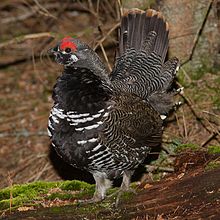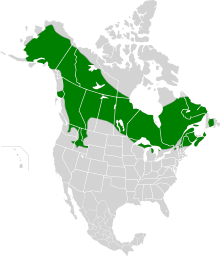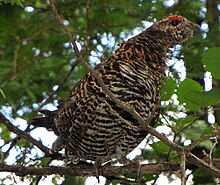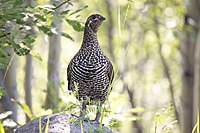
The Phasianidae are a family of heavy, ground-living birds, which includes pheasants, partridges, junglefowl, chickens, turkeys, Old World quail, and peafowl. The family includes many of the most popular gamebirds. The family is a large one and includes 185 species divided into 54 genera. It was formerly broken up into two subfamilies, the Phasianinae and the Perdicinae. However, this treatment is now known to be paraphyletic and polyphyletic, respectively, and more recent evidence supports breaking it up into two subfamilies: Rollulinae and Phasianinae, with the latter containing multiple tribes within two clades. The New World quail (Odontophoridae) and guineafowl (Numididae) were formerly sometimes included in this family, but are now typically placed in families of their own; conversely, grouse and turkeys, formerly often treated as distinct families, are now known to be deeply nested within Phasianidae, so they are now included in the present family.
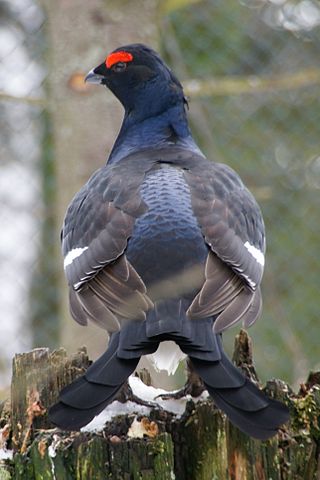
The black grouse, also known as northern black grouse, Eurasian black grouse, blackgame or blackcock, is a large game bird in the grouse family. It is a sedentary species, spanning across the Palearctic in moorland and steppe habitat when breeding, often near wooded areas. They will spend the winter perched in dense forests, feeding almost exclusively on the needles of conifers. The black grouse is one of two species of grouse in the genus Lyrurus, the other being the lesser-known Caucasian grouse.

The American coot, also known as a mud hen or pouldeau, is a bird of the family Rallidae. Though commonly mistaken for ducks, American coots are only distantly related to ducks, belonging to a separate order. Unlike the webbed feet of ducks, coots have broad, lobed scales on their lower legs and toes that fold back with each step to facilitate walking on dry land. Coots live near water, typically inhabiting wetlands and open water bodies in North America. Groups of coots are called covers or rafts. The oldest known coot lived to be 22 years old.

The willow ptarmigan is a bird in the grouse subfamily Tetraoninae of the pheasant family Phasianidae. It is also known as the willow grouse and in Ireland and Britain, where the subspecies L. l. scotica was previously considered to be a separate species, as the red grouse. It breeds in birch and other forests and moorlands in northern Europe, the tundra of Scandinavia, Siberia, Alaska and Canada, in particular in the provinces of Newfoundland and Labrador and Quebec. It is the state bird of Alaska. In the summer the birds are largely brown, with dappled plumage, but in the winter they are white with some black feathers in their tails. The species has remained little changed from the bird that roamed the tundra during the Pleistocene. Nesting takes place in the spring when clutches of four to ten eggs are laid in a scrape on the ground. The chicks are precocial and soon leave the nest. While they are young, both parents play a part in caring for them. The chicks eat insects and young plant growth while the adults are completely herbivorous, eating leaves, flowers, buds, seeds and berries during the summer and largely subsisting on the buds and twigs of willow and other dwarf shrubs and trees during the winter.

The western capercaillie, also known as the Eurasian capercaillie, wood grouse, heather cock, cock-of-the-woods, or simply capercaillie, is a heavy member of the grouse family and the largest of all extant grouse species. The heaviest-known specimen, recorded in captivity, had a weight of 7.2 kilograms. Found across Europe and the Palearctic, this primarily-ground-dwelling forest grouse is renowned for its courtship display. The bird shows extreme sexual dimorphism, with males nearly twice the size of females. The global population is listed as "least concern" under the IUCN, although the populations of central Europe are declining and fragmented, or possibly extirpated.
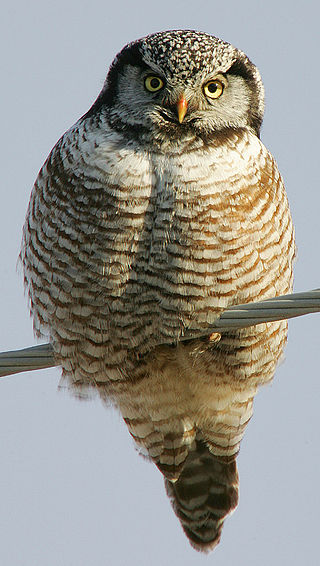
The northern hawk-owl or northern hawk owl is a medium-sized true owl of the northern latitudes. It is non-migratory and usually stays within its breeding range, though it sometimes irrupts southward. It is one of the few owls that is neither nocturnal nor crepuscular, being active only during the day. This is the only living species in the genus Surnia of the family Strigidae, the "typical" owls. The species is sometimes called simply the hawk owl; however, many species of owls in the genus Ninox are also called "hawk owls".

The tree swallow is a migratory bird of the family Hirundinidae. Found in the Americas, the tree swallow was first described in 1807 by French ornithologist Louis Vieillot as Hirundo bicolor. It has since been moved to its current genus, Tachycineta, within which its phylogenetic placement is debated. The tree swallow has glossy blue-green upperparts, with the exception of the blackish wings and tail, and white underparts. The bill is black, the eyes dark brown, and the legs and feet pale brown. The female is generally duller than the male, and the first-year female has mostly brown upperparts, with some blue feathers. Juveniles have brown upperparts, and grey-brown-washed breasts. The tree swallow breeds in the US and Canada. It winters along southern US coasts south, along the Gulf Coast, to Panama and the northwestern coast of South America, and in the West Indies.

The black-billed cuckoo is a New World species in the Cuculidae (cuckoo) family. The scientific name is from Ancient Greek. The genus name, kokkuzo, means to call like a common cuckoo, and erythropthalmus is from eruthros, "red" and ophthalmos, "eye".

The yellow-bellied sapsucker is a medium-sized woodpecker that breeds in Canada and the northeastern United States.

The Canada jay, also known as the gray jay, grey jay, camp robber, or whisky jack, is a passerine bird of the family Corvidae. It is found in boreal forests of North America north to the tree line, and in the Rocky Mountains subalpine zone south to New Mexico and Arizona. A fairly large songbird, the Canada jay has pale grey underparts, darker grey upperparts, and a grey-white head with a darker grey nape. It is one of three members of the genus Perisoreus, a genus more closely related to the magpie genus Cyanopica than to other birds known as jays. The Canada jay itself has nine recognized subspecies.
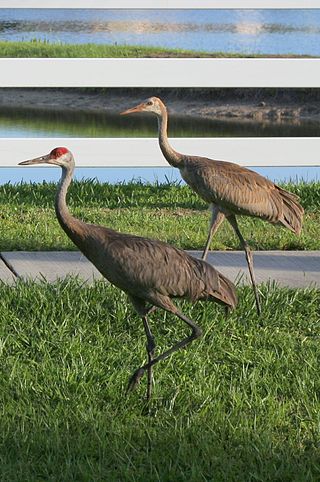
The sandhill crane is a species of large crane of North America and extreme northeastern Siberia. The common name of this bird refers to their habitat such as the Platte River, on the edge of Nebraska's Sandhills on the American Great Plains. Sandhill cranes are known to frequent the edges of bodies of water. The central Platte River valley in Nebraska is the most important stopover area for the nominotypical subspecies, the great sandhill crane, with up to 450,000 of these birds migrating through annually.

The broad-winged hawk is a medium-sized hawk of the genus Buteo. During the summer, some subspecies are distributed over eastern North America, as far west as British Columbia and Texas; they then migrate south to winter in the Neotropics from Mexico south to southern Brazil. Other subspecies are all-year residents on Caribbean islands. As in most raptors, females are slightly larger than males. Broad-winged hawks' wings are relatively short and broad with a tapered, somewhat pointed appearance. The two types of coloration are a dark morph with fewer white areas and a light morph that is more pale overall. Although the broad-winged hawk's numbers are relatively stable, populations are declining in some parts of its breeding range because of forest fragmentation.
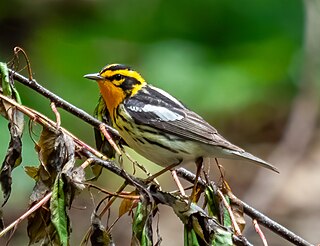
The Blackburnian warbler is a small New World warbler. They breed in eastern North America, from southern Canada, westwards to the southern Canadian Prairies, the Great Lakes region and New England, to North Carolina.

The magnolia warbler is a member of the wood warbler family Parulidae.

The Siberian grouse, also known as Siberian spruce grouse, Amur grouse, or Asian spruce grouse, is a short, rotund forest-dwelling grouse. A sedentary, non-migratory bird, it is the only member of the genus Falcipennis. The spruce grouse of North America, which physically looks similar, is now placed in the monotypic genus Canachites.
Gamebird hybrids are the result of crossing species of game birds, including ducks, with each other and with domestic poultry. These hybrid species may sometimes occur naturally in the wild or more commonly through the deliberate or inadvertent intervention of humans.

Szechenyi's monal-partridge, also known as buff-throated partridge or buff-throated monal-partridge, is a member of the family Phasianidae in the order Galliformes. They are endemic to western China.

The sooty grouse is a species of forest-dwelling grouse native to North America's Pacific Coast Ranges. It is closely related to the dusky grouse, and the two were previously considered a single species, the blue grouse.

The Alberta–British Columbia foothills forests are a temperate coniferous forests ecoregion of Western Canada, as defined by the World Wildlife Fund (WWF) categorization system. This ecoregion borders Canada's taiga and contains a mix of subarctic forest and temperate forest species as a result. This makes the region an ecotone region, or a region that acts as a buffer between two other biomes.

Franklin's grouse is a subspecies of the spruce grouse found in the Northwest Territories, British Columbia, and Alberta.
